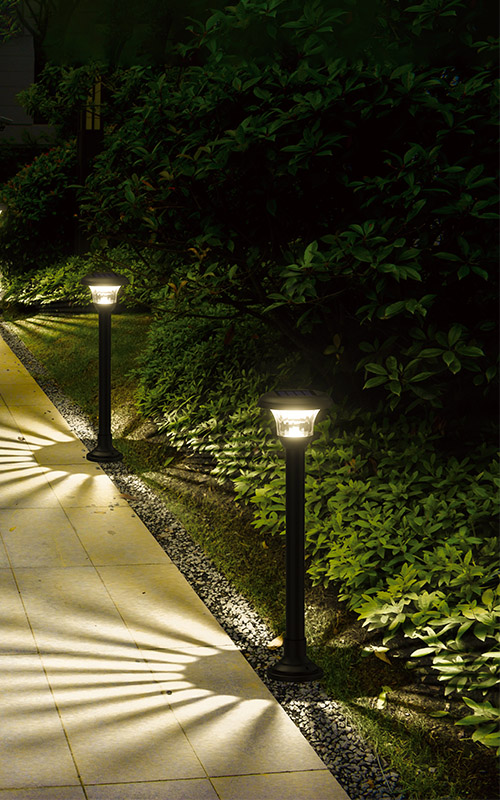Illuminating the Outdoors: Comparing LED Solar Pathway Lights to Traditional Outdoor Lighting
2024-06-20
Outdoor lighting plays a crucial role in enhancing the beauty and safety of our homes. As technology advances, homeowners face an array of options, each with distinct advantages and drawbacks. Two prominent contenders in the outdoor lighting arena are LED solar pathway lights and traditional outdoor lighting options. This blog delves into a comparative analysis of these lighting solutions, focusing on brightness and efficiency.
Brightness: Illuminating the Path
LED Solar Pathway Lights:
LED solar pathway lights have made significant strides in recent years. Early versions were often criticized for their dimness, but technological advancements have substantially improved their brightness. Modern LED solar lights can emit a bright, consistent light comparable to that of low-wattage traditional bulbs. The brightness of these lights is measured in lumens, and high-quality solar pathway lights typically range between 10 to 100 lumens per light, depending on the model and purpose.
Traditional Outdoor Lighting:
Traditional outdoor lighting, which includes incandescent, halogen, and non-solar LED lights, generally offers a wider range of brightness levels. Incandescent and halogen bulbs can produce very high lumen outputs, making them suitable for applications requiring intense illumination. Non-solar LED lights, known for their efficiency and brightness, often range from 200 to 1000 lumens or more. This makes traditional lighting options versatile for various outdoor needs, from pathway lighting to spotlighting large areas.
Efficiency: Power Consumption and Environmental Impact
LED Solar Pathway Lights:
Efficiency is where LED solar pathway lights truly shine. These lights harness solar energy during the day and store it in rechargeable batteries, making them incredibly energy-efficient and environmentally friendly. They operate independently of the electrical grid, reducing electricity consumption and utility costs. Additionally, the lifespan of LED bulbs is significantly longer than traditional bulbs, often lasting up to 25,000 to 50,000 hours. The energy conversion efficiency of solar panels, though variable, continues to improve, contributing to the overall efficiency of solar lighting systems.
Traditional Outdoor Lighting:
Traditional outdoor lighting options, particularly incandescent and halogen bulbs, are less efficient in terms of energy consumption. Incandescent bulbs convert only about 10% of the energy they use into light, with the rest lost as heat. Halogen bulbs are slightly more efficient but still lag behind LED technology. Non-solar LED lights, however, are much more efficient, converting about 80-90% of their energy into light. Despite their efficiency, traditional LED lights rely on grid electricity, which may be sourced from non-renewable resources, impacting their overall environmental footprint.
Cost Considerations
LED Solar Pathway Lights:
The initial cost of LED solar pathway lights can be higher compared to traditional options. However, the long-term savings on electricity bills and minimal maintenance costs often offset the upfront investment. Solar lights require little to no wiring, reducing installation costs and complexity. Over time, the renewable nature of solar energy can lead to significant cost savings.
Traditional Outdoor Lighting:
Traditional outdoor lighting options, especially incandescent and halogen lights, are generally cheaper upfront but can be more expensive over time due to higher electricity bills and more frequent bulb replacements. Non-solar LED lights, while more expensive than incandescent bulbs, offer a balance between initial cost and long-term savings due to their efficiency and durability.
Installation and Maintenance
LED Solar Pathway Lights:
Installation of LED solar pathway lights is straightforward, involving minimal wiring or trenching. These lights can be placed in various locations without needing a direct connection to the electrical grid. Maintenance is also minimal, typically involving occasional cleaning of solar panels and battery replacements after several years of use.
Traditional Outdoor Lighting:
Installing traditional outdoor lighting can be more complex and costly, especially if extensive wiring and electrical work are required. Maintenance involves more frequent bulb replacements and potential electrical repairs, adding to the ongoing costs and effort.
Conclusion
When comparing LED solar pathway lights to traditional outdoor lighting options, both have their distinct advantages and ideal use cases. LED solar lights excel in energy efficiency, environmental impact, and ease of installation, making them an excellent choice for eco-conscious homeowners and those seeking long-term cost savings. On the other hand, traditional outdoor lighting, particularly non-solar LED options, offers superior brightness and versatility, making them suitable for areas requiring high-intensity illumination.
Ultimately, the choice between LED solar pathway lights and traditional outdoor lighting depends on your specific needs, budget, and environmental considerations. Embracing the advancements in solar technology could illuminate not only your pathways but also pave the way for a greener future.



